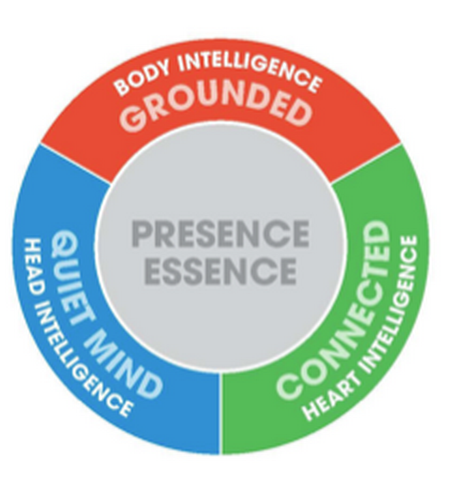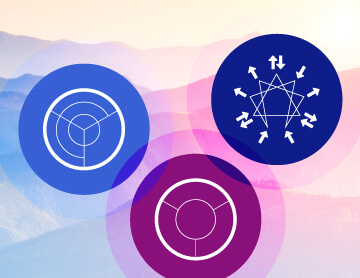Introduction
We have seen that Mindfulness and the Enneagram naturally resonate well with each other. The Enneagram is a sense-making tool that helps us to move into deeper states of self-awareness, often referred to as meta-awareness. When we are invited into the journey of mindfulness, we realise that being anchored in the here and now, creates a space where we are open to access our innate potential and able to 'see' alternative perspectives. Being present with ourselves, not only makes our growth journey more authentic but also enriches it and transform our functioning into higher states of being.
This article further explores the connection between the Enneagram and Mindfulness, through the lens of understanding and working with the Centres of Intelligence. The Centers refers to one of the primary triads or fractals within the Enneagram - reminding us that we all have access to Action, Feeling and Thinking. There are three different ways to working with these Centres, of which the Centers of Intelligence is one way, often also referred to as the 'transformational' approach to the Centers because it focuses on the intelligence or quality of the centers, not just how preferentially or strongly they are expressed.
First, let's revisit the foundations of mindfulness and then build on these.
Mindful Presence
Rick Hanson, a psychologist and Senior Fellow of the Greater Good Science Center at UC Berkeley, and New York Times best-selling author said that mindfulness is an everyday psychological activity. He states that when you are mindful of something, you are observing it and not caught up in it nor identifying with it. The ego becomes the observer and the term "observing ego" is considered healthy for our functioning, detaching from the stream of consciousness and to merely observe this. Other terms describing this aspect of the ego are "bare witnessing" or "fair witness".
Hanson further differentiates between mindfulness and presence. Mindfulness is the awareness of our inner and our outer worlds in a way that is non-judgemental. For us to be mindful, we need to be particularly aware of the flow of our experience of our inner world in a way that we are able to observe our emotions, body sensations, attitudes, memories, visual images and attitudes. Presence refers to the degree to which we are grounded in the practice of awareness itself. As we practice mindfulness more and more, we get to a state where awareness become our default state. This state is less focused on the contents of our awareness, where we are susceptible to being caught up in them and where these contents can derail us and trip us up.
In this state of mindful presence, we are effectively accessing our true being. Doing and having becomes less important as we are increasingly present in a mindful space. In our interaction with people, they become more aware that we are fully there with them, aware of what is happening in the interaction and identify less with reactions that might arise, whether these are pleasant or unpleasant. Mindful presence is a state where "being" becomes a way of life!
But how do we access this state of being and how can the Enneagram help us to navigate into this "being" space?
Evidence for the Centers of Intelligence
Recent findings in neuroscience have uncovered that we have complex and functional neural networks located in our heart and gut. With this scientific credence, our assertions about the so called three "brains" or "intelligences" are given more weight or gravitas. Ancient teachings have emphasized these intelligences and the subsequent wisdom that we are able to unleash if we indeed are tapping into our head (cephalic brain), heart (cardiac brain) and gut (enteric brain).
Recently, neuroscience has proven that there is truth in these teachings. Our bodies, thus have not only one, but three different brains. Each of these organs, have the ability to store and equally process information with the associated complex neuro networks. These brains are working together all the time. We have millions of neurons in our intestines that form the gut-brain and more than 40,000 neurons in our heart-brain. Each of these 'brains' meets all the criteria required to function as a brain, and can sense, feel, learn and remember, utilising several types of neurons, neurotransmitters, proteins and support cells to enable their functioning.
Each of these 'brains' thus give us access to a different way of knowing, and the Enneagram offers us a lens to access these deeply seated intelligences.
The Centers of Intelligence
A person can tap into the best of their Centers by becoming present and mindful. Each of the Centers then offers us a point of contact to access the intelligence that is seated in the centre. A Center of Expression becomes intelligent when we are able to be present to it in a grounded, open-hearted and clear way.

This deepening mindfulness works parallel to the levels of development within each Type. As a person becomes present to the intelligence of a centre,
they integrate and express a higher level of development. At this level the Center is transformed from the expression of action, thinking and feeling
to a higher order of body, heart and head-centred intelligence. The body Center becomes grounded and alive, the head Center becomes quiet, spacious
and trusting and the heart Center becomes receptive, open-hearted and authentic.
Each of these "brains", the head, heart and gut or Centers of
intelligence have different goals, and subsequently different ways of processing information with different domains of competence.
But there is also a word of caution in being present in these centres. We need to be cognisant that accessing and using the Center does not equate to mindfulness; suggesting that out of balance access to a Center is not necessarily healthy or using that Center necessarily well. For example, when we over-think, it can lead to analysis-paralysis where we struggle to move to action. In the next section, we unpack each of these Centers in more detail.
Working with the Body Centre
When the body Center is intelligent, it is calm and allows us to feel grounded and alive. Slowing down, we learn how to listen to the sensations in our body. Tapping into this Center of intelligence gives us courage to express our deepest sense of self by empowering us to act in ways that are true to what is important to us according to who we really are. Accessing this groundedness, we develop courage to act from our deepest sense of identity and in a way that we are not trapped in a fear-based reaction. We are able to be persistent and drive action to impact our environment.
This Center of intelligence empowers us to move into action from a place that will not back down or capitulate when we see a challenge or sense resistance. We are grounded and courageously alive to act on our visions, dreams and goals. Ungrounded behaviour can lead to unhealthy action, which becomes excessive and can be mindless, leading to a lack of focus and typically reactive responses. Others might observe behaviour as impulsive, driven by an over-active will to act. This pattern may lead to others feeling that they cannot participate or keep up and disengage as a result. Unhealthy action may be driven by us not being able to be authentic due to a fear of things that are unknown, uncertain or unfamiliar.
To illustrate, Jo and Sarah are working in the same team tasked to provide input into their organisation's latest marketing strategy. Jo is courageous and comfortable to present their ideas. He answers the questions from the panel in depth and delivers a good business case that is grounded in a strong identity. Sarah is somewhat taken aback by the questions and wants to go back to the drawing board and start afresh. These different actions indicate a contrast between Jo and Sarah. Jo was able to access his body Center of intelligence in a healthy way by being grounded. Sarah's action was mindless, somewhat excessive and unhealthier. Sarah will benefit from accessing this Center by slowing down and listening to the sensations in her body.
Working with the Heart Centre
The heart Center of intelligence refers to the authentic connection and expression of the self by accessing your inner truth. When our heart Center is intelligent, then we are able to express ourselves in an authentic manner, and to be warm, empathic, attuned to the emotions and needs of others; being emotionally sensitive and available.
Accessing the heart Center of intelligence helps us to be emotionally connected in our relationships, expressing compassion in the sense that we really care enough. Our highest expression using this Center of intelligence is to connect with, value and relate to human needs and the human condition of the self and the other.
When we are excessively connected to our heart centres, it may lead to being overly sensitive to the point of being absorbed in the needs of others. Dysfunctional behaviour such as emotional manipulation in relationships are examples in this category.
Back to our example, when presenting their ideas, Jo was able to speak to the audience and reacting to their questions in a warm and empathetic way. He made sure that everyone in the room felt heard and took time to explain elements that were unclear. Sarah, on the other hand, was more erratic and her presentation were experienced as forceful, pushing and controlling. Sarah will benefit from connecting to her heart Center more to value and relate to others in a more authentic manner.
Working with the Head Centre
The head Center of intelligence offers us a quiet trusting space for new consciousness to emerge. Using our head Center of intelligence not only refers to the objective, analytical and detailed reasoning and processing of information, but also our ability to create meaning through semantic processing, using language and metaphors.
Accessing the head Center provides us with the opportunity to generate new perspectives and new thinking that can transform our world. It can lead to creativity and generative thinking.
When we are in a state of excessive thinking, we are likely to struggle with moving from planning to action; in other words, struggling to get out of the starting blocks. We are for example typically over-thinking.
This can be seen in our example, as in their preparation for the presentation, Sarah procrastinated a bit and was planning and re-planning, creating more and more scenarios to cover all possible angles. Jo, trusted their preparation and was confident in their business case and the value that their ideas will create. Sarah will benefit from accessing her head Center more to allow space for new ideas and creativity to emerge.
In the above discussion, we have illustrated the value of accessing each of the Centers of intelligence. We have also proposed that mindfulness allows us to be truly connected to each of these centres. Through this authentic connection, we are able to access the intelligence that is deeply seated in the centre.
Practicing mindful presence
Earlier in this article, we introduced the idea of mindful presence as a state where we are able to access our being, where the 'doing' and 'having' pieces are less important. In a state of mindful presence, we do not react to any of our sensations, thoughts or feelings, but simply become aware of them, noticing them. The Enneagrams Centers of Intelligence gives us three ways of connecting to these intelligences, however we need to be fully present in each of these to activate their intelligence.
Below are some characteristics of what it means to be in the "being" mode:
- Attention: Not distracted with the mind focused on its own experience in the moment.
- Living in the moment: Present in the here and now, not engaging with any thought, memory or idea about the past or future that comes to mind.
- Responsiveness: Not reacting to any distractions that came your way, simply notice them and let them drift away.
- Non-judgement: Not judging all against "should" - thinking, for example what should have happened or what should be happening.
- Acceptance: Compassionate with yourself whenever you are reflecting on anything that you think you have done wrong - not being critical or engaging in dialogue where you have disappointed yourself.
- Passivity: Not accidentally slipping into the doing mode, by making decisions, making plans or engage in problem solving.
- Non-engagement: Distant from emotion or unwanted thoughts that came your way.
Conclusion
Mindfulness increases our ability to observe the sensations in our body, and become aware of our thoughts and feelings in a way that we are not attached to them. Being mindful, provides us with an avenue to access the wisdom in each of the Centers of intelligence. It starts with embracing practices that enable an individual to be in touch with each centre's particular way of being in the world.
We have also learned that these intelligences build on each other, for example presence of our body Center of intelligence opens the door to presence of the heart Center of intelligence which in turn opens the door to the mind Center of intelligence.
Creating a state of mindful presence doesn't mean that we ignore our gut, feelings and thoughts, but rather that we became aware of them, not getting caught up in them and not allowing ourselves to be controlled by them.
STOP STRESSING, START GROWING Get your iEQ9 Enneagram Test

 What is the Enneagram?
What is the Enneagram?
 Introduction to the 27 Subtypes
Introduction to the 27 Subtypes
 Introduction to the 3 Centers
Introduction to the 3 Centers
 Wings
Wings
 Lines and Integration
Lines and Integration
 Enneagram History & Origin
Enneagram History & Origin
 Enneagram for Myself
Enneagram for Myself
 Enneagram for Practitioners
Enneagram for Practitioners
 Enneagram for Business
Enneagram for Business
 iEQ9 Individual Reports
iEQ9 Individual Reports
 iEQ9 Team Reports
iEQ9 Team Reports
 iEQ9 Questionnaire
iEQ9 Questionnaire
 Training Events
Training Events
 Level 1 iEQ9 Accreditation
Level 1 iEQ9 Accreditation
 Level 2 Enneagram Team Dynamics
Level 2 Enneagram Team Dynamics
 International Enneagram Conference
International Enneagram Conference
 iEQ9 Community of Practice Events
iEQ9 Community of Practice Events
 About Integrative9
About Integrative9
 Meet the Faculty
Meet the Faculty
 Testimonials
Testimonials
 Contact Us
Contact Us



